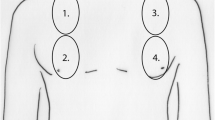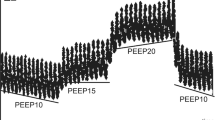Abstract
The authors examined the usefulness of sodium chloride as a nondiffusible indicator during the first passage through dogs' lungs, before and after increased-permeability pulmonary oedema produced by an intravenous injection of alloxan. With an injection of a mixture of ice-cold 3 per cent sodium chloride and indocyanine green dye (a nondiffusible reference indicator), the authors simultaneously recorded three dilution curves from the aortic root: dye dilution, thermal and blood electrical conductivity dilution curves in six dogs. The mean transit time of sodium chloride in the conductivity dilution curve was significantly different from, but fairly equal to, that of indocyanine green dye (6·2±1·4 s (mean±SD) against 6·5±1·4s(p<0.01) in the baseline period, and 7·6±1·9 s against 8·4±2·1 s (p<0·01) in the oedema period, respectively). The calculated extravascular lung thermal volume with the thermal and conductivity dilution method (Y, ml kg−1) correlated well with the gravimetrically determined extravascular lung mass in a total of 12 dogs, including six other dogs without intervention (x, g kg−1) (y=0·72x±3·03, r=0·96). The authors conclude that sodium chloride is useful as a nondiffusible indicator in the first passage through the lungs, and that the thermal and conductivity dilution method is also useful for measuring extravascular lung water mass.
Similar content being viewed by others
References
ANDERSON, W. P., DUNEGAN, L. J., KNIGHT, D. C., FITZPATRICK, G. F., O’CONNOR, N. E. and MORGAN, A. P. (1975) Rapid estimation of pulmonary extravascular water with an instream catheter. J. Appl. Physiol., 39, 843–845.
ARAKAWA, M., KAMBARA, K., SEGAWA, T., MIYAZAKI, H., ANDO, F., KAWADA, T. and HIRAKAWA, S. (1988) A method for removing prolongation of mean transit time due to response time. Phys. in Med. Biol., 33, Suppl. I, 146.
BAKER, K. J. (1966) Binding of sulfobromophthalein (BSP) sodium and indocyanine green (ICG) by plasma al lipoprotein. Proc. Soc. Exp. Biol. Med., 122, 957–963.
BAUMAN, A., ROTHSCHILD, M. A., YALOW, R. S. and BERSON, S. A. (1957) Pulmonary circulation and transcapillary exchange of electrolytes. J. Appl. Physiol,, ll, 353–361.
BLAND, J. M. and ALTMAN, D.G. (1986) Statistical methods for assessing agreement between two methods of clinical measurement. Lancet, 1, 307–310.
CHERRICK, G. R., STEIN, S. W., LEEVY, C. M. and DAVlDSON, C. S. (1960) Indocyanine green: observations on its physical properties, plasma decay, and hepatic extraction. J. Clin. Invest., 39, 592–600.
CHINARD, F. P. (1966) The permeability characteristics of the pulmonary blood-gas barrier. In Advances in respiratory physiology. CARO, C. G. (Ed.), Arnold, London, 106–147.
CHINARD, F. P. and CUA, W. O. (1987) Endothelial extraction of tracer water varies with extravascular water in dog lungs. Am. J. Physiol., 252, H340–348.
GUMP, F. E., MASHIMA, Y., JORGENSEN, S. and KINNEY, J. M. (1971) Simultaneous use of three indicators to evaluate pulmonary capillary damage in man. Surg., 70, 262–270.
ISHIBE, Y., SUEKANE, K., UMEDA, T., NAKAMURA, M., IZUMI, T.. SAGAWA, Y., SAXON, K. and OHI, M. (1986) Basic research on double indicator dilution method using heat and sodium ions for measurement of pulmonary edema in vivo. (Abstract in English). Respirat., 5, 337–342.
LEWIS, F. R., ELLINGS, V. B., HILL, S. L. and CHRISTENSEN J. M. (1982) The measurement of extravascular lung wa~er by thermal-green dye indicator dilution. In Mechanisms of lung microvascular injury. MALIK, A. B. and STAUB, N. C. (Eds.). New York Acad. Sci., 349–410.
LILIENFIELD, L. S. and KOVACH, R. D. (1956) Simplified method for calculating flow, mean circulation time and downslope from indicator-dilution curves. Proc. Soc. Exp. Biol. Med., 91, 595–598.
NOBLE, W. H. and SEVERINGHAUS, J. W. (1972) Thermal and conductivity dilution curves for rapid quantitation of pulmonary edema. J. Appl. Physiol., 32, 770–775.
NOBLE, W. H., OBDORZALEK, J. and KAY, J. C. (1973) A new technique for measuring pulmonary edema. Ibid., 34, 508–512.
NOBLE, W. H., KAY, J. C., MARET, K. H. and CASKANETTE, G. (1980) Reappraisal of extravascular lung thermal volume as a measure of pulmonary edema. Ibid., 48, 120–129.
PEARCE, M. L. (1969) Sodium recovery from normal and edematous lungs studied by indicator dilution curves. Circ. Res., 24, 815–820.
RICE, D. L. and MILLER, W. C. (1981) Flow-dependence of extravascular thermal volume as an index of pulmonary edema. Int. Care Med., 7, 269–275.
SEL1NGER, S. L., BLAND, R. D., DEMLING, R. H. and STAUB, N. C. (1975) Distribution volumes of [1311]albumin, and 36C1 in sheep lung. J. Appl. Physiol., 39, 773–779.
YUDILEVICH, D. (1961) Transport of K 42+, Na 24+, and 1131- by the pulmonary circulation. Calculations of cardiac output and volume from dilution curves obtained in the canine heart-lung preparation. Circ. Res., 9, 925–935.
ZIERLER, K. L. (1962) Circulation times and the theory of indicator-dilution methods for determining blood flow and volume. In Handbook of physiology: Circulation. HAMILTON, W. F. (Ed.) Am. Physiol. Soc., Washington, DC, 585–615.
Author information
Authors and Affiliations
Rights and permissions
About this article
Cite this article
Arakawa, M., Kambara, K., Segawa, T. et al. Usefulness of sodium chloride as a nondiffusible indicator in the measurement of extravascular lung thermal volume in dogs. Med. Biol. Eng. Comput. 31 (Suppl 1), S67–S72 (1993). https://doi.org/10.1007/BF02446652
Received:
Accepted:
Published:
Issue Date:
DOI: https://doi.org/10.1007/BF02446652




